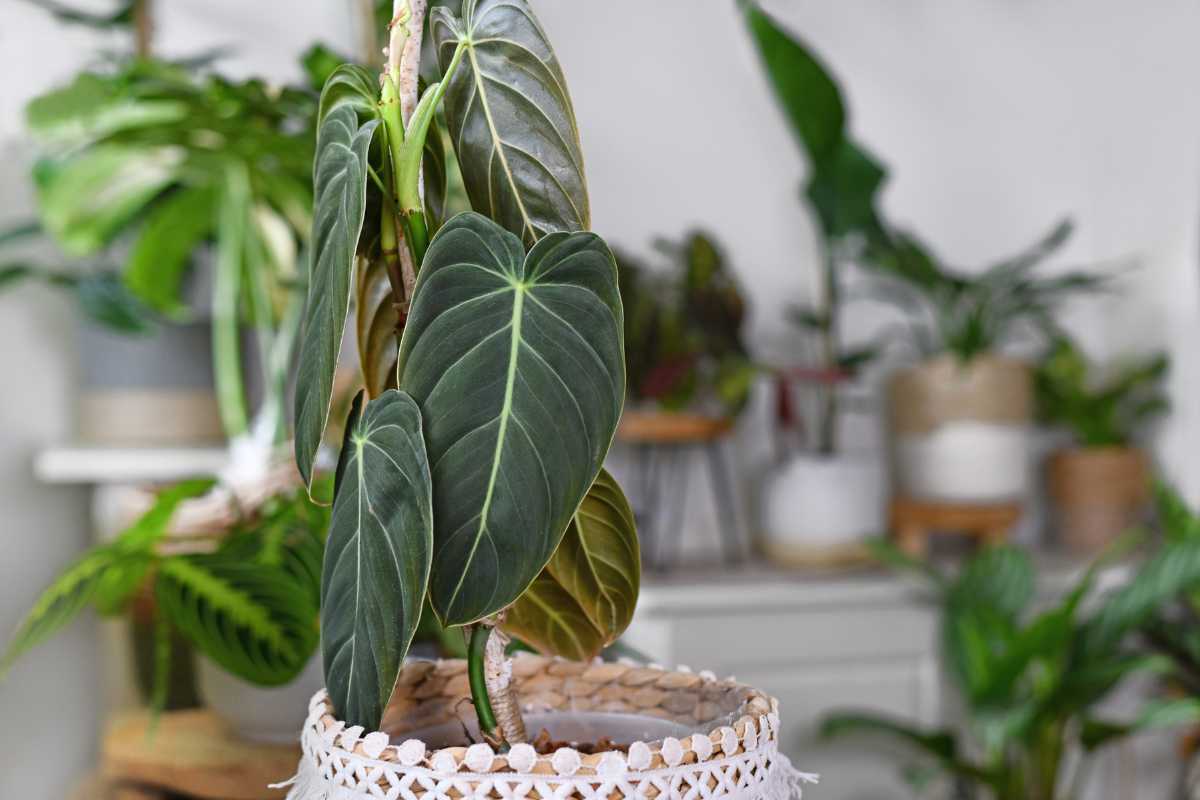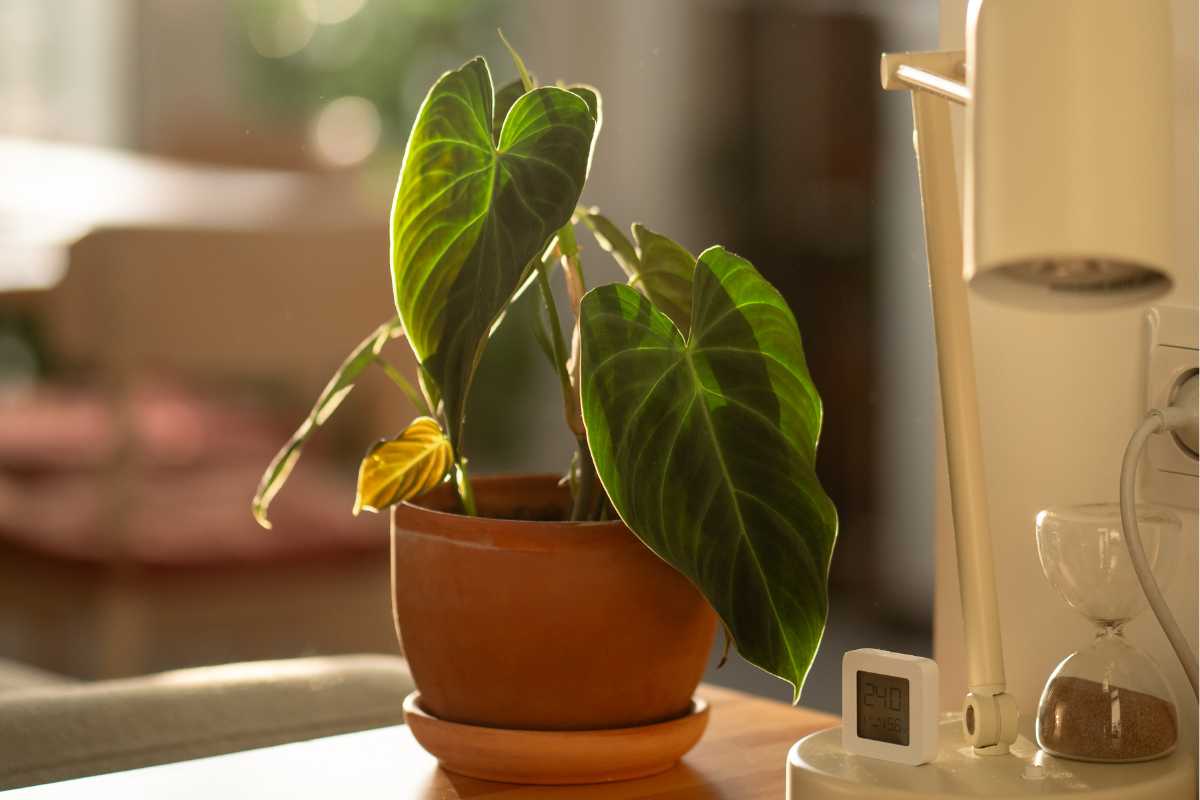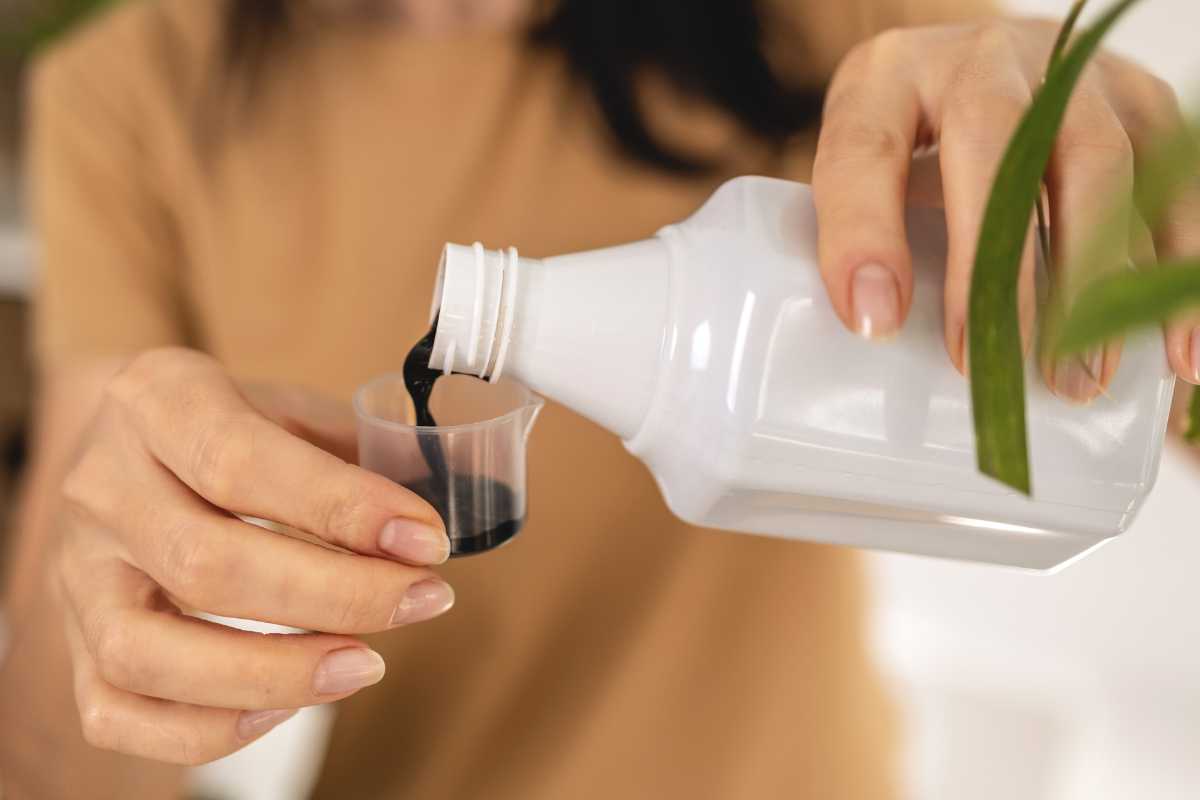The Philodendron Melanochrysum is a rare tropical plant with beautiful dark green, velvet leaves. This houseplant is easy to care for.
Follow this guide to learn how to care for the philodendron melanochrysum.
Philodendron Melanochrysum Overview

Also referred to as the Black Gold Philodendron, the Philodendron Melanochrysum is a rare vining philodendron with gorgeous foliage. Leaves have a velvety texture with striking yellow veins. These leaves can grow to be quite large, in fact, as much as two feet in length.
As with all philodendron varieties, care and maintenance is easy. The hard part is managing to get on in your hands due to its rarity.
A member of the Araceae family, the Philodendron Melanochrysum is a perennial tropical plant native to Costa Rica and South America including Columbia. It can be cultivated outdoors in USDA hardiness zones 9a through 11b.
The Melanochrysum philodendron can grow up to twelve feet tall and eight feet wide. When cultivated indoors as a houseplant, it will most likely not grow taller than five feet or wider than two feet in size.
Philodendron Melanochrysum Care Guide
As a South American tropical native, this philodendron loves a warm, humid environment with filtered or dappled sunlight with regular watering. As the Melanochrysum plant increases in size, it will benefit from some kind of structured support such as a trellis or moss pole, because it also loves to climb.
Soil for the Philodendron Melanochrysum
Whatever soil mix you opt for when cultivating this philodendron, it needs well-draining soil, yet still be able to retain moisture. It also should have high-quality organic matter for nutritional purposes.
If you want to blend a custom mix for your plant, try one part orchid bark or similar, one part peat moss, and one part perlite.
Cultivation in sphagnum moss is an option, as is a quality potting mix amended with perlite, charcoal, and peat. Ideally, the soil pH level will measure between 5.5 and 6.0.
Light for the Philodendron Melanochrysum

This philodendron, like other members of the philodendron genus, is an understory plant in the tropical forest, meaning they are not naturally exposed to direct sunlight. They grow under a canopy of trees and taller plants, so they do get bright indirect light.
When cultivating your Melanochrysum plant, choose a location, whether indoor or outside, that does not shine direct light on the leaves as they will burn or scorch easily.
Water and Humidity for the Philodendron Melanochrysum
Tropical plants require a steady supply of water to thrive and grow into a beautiful plant.
The standard rule of thumb with the Philodendron Melanochrysum is to water it when the top two inches of the soil bed is dry. You can stick your finger into it to know when it’s time to water.
To guarantee that the entire root system gets a drink, try soaking your plant and allowing the excess water to drain completely out of the drainage holes before returning the plant pot to its location.
Like all native tropical plants, the Philodendron Melanochrysum prefers a warm, humid environment. Average home humidity is sufficient, but ideally, a humidity level of 60% or higher is better. Humidity aids in keeping your plant well-hydrated.
Dry air in your home can be adjusted by increasing the humidity where your plant is located. Any one of the following methods will give your humidity levels a boost:
- Pebble and water tray
- Humidifier for plants
- Misting your plant often
- Grouping a few plants together.
Temperature for the Philodendron Melanochrysum
The Philodendron Melanochrysum likes average home temperatures, so if you are comfortable, your philodendron will be as well.
Consider an environmental temperature range between 70° and 80°F for a happy plant. Temperatures should never dip lower than 60°F.
Fertilizer for the Philodendron Melanochrysum

The Melanochrysum is not a heavy feeder, but they do require nutrition to survive and thrive. The base foundation for nutrition is a nutrient-rich soil bed.
You can fertilize this philodendron monthly during its growing season with an NPK 20-20-20 fertilizer diluted to half-strength.
In the winter months during its dormant period, you can feed them every two months or choose not to feed them. Always fertilize when the soil bed is moist to avoid burning roots.
Pruning the Philodendron Melanochrysum
Pruning is a good tool if you want a fuller plant. If the plant looks leggy, trim it back some. Trim away any damaged or dead foliage. Springtime is ideal for pruning as its during their growing season.
Repotting the Philodendron Melanochrysum
The need for repotting will depend on how quickly your plant grows. It’s a moderate grower and usually takes a year or two for this plant to outgrow its pot.
When repotting, move to a container that is one to two sizes larger.
Propagating the Philodendron Melanochrysum

As a vining philodendron, the easiest method for propagating your Melanochrysum is by using stem cuttings. Another option is to use air layering.
When pruning, you can use those cuttings for propagation purposes. Always propagate during the growing season.
How to Propagate with a Stem Cutting
- To start, spring is the ideal time for to begin propagation.
- With sterilized scissors, cut a stem approximately four inches long below a leaf node. The cutting should have at least a couple of leaf nodes and the bottom foliage should be removed.
- Stem cuttings can be cultivated in water or soil mix.
- For water cultivation, change the water in the jar every 5-7 days. Once the roots measure an inch long, you can transfer the stem cutting to a container with potting mix. After a couple of weeks, root growth should be apparent. When roots reach approximately an inch long, they can be transferred to moistened potting mix.
- For cultivation in potting soil, create a hole with your finger in moist potting soil and place your cutting in the hole. Move the soil around the base of the stem cutting to fill the hole.
- Your cutting should be placed in a warm space with bright indirect light.
- After several weeks, the roots will form, and they can be transferred to a larger pot if necessary.
How to Propagate with Air Layering
Air Layering as a propagation method can only be used during the growing season in the spring.
- Select a stem section on the plant.
- Remove any extra foliage in the stem section and slice it vertically.
- Place a toothpick in the stem to keep the slice open.
- Place peat moss and soil around the wound and wrap it in plastic wrap. Close the ends of the plastic with ties to increase the humidity around the wound, but do not bind it too tightly.
- When new roots emerge, you can remove the plastic and cut just below the stem section with the new roots.
- Transplant the new cutting with roots into a pot with potting soil.
Philodendron Melanochrysum Toxicity and Pets
The Melanochrysum and all members of the Philodendron genus are toxic to domestic animals. The ASPCA, American Society for the Prevention of Cruelty to Animals, tells us that Philodendrons are toxic to our pets because they contain calcium oxalate crystals.
It is recommended that philodendrons are kept out of the reach of all pets and small children.
Calcium oxalate crystals can be the cause of respiratory problems, nausea, diarrhea, irritation, and swelling upon contact. Chewing, eating, or swallowing Philodendrons can contribute to kidney failure in domestic animals.
Symptoms of calcium oxalate crystal ingestion and poisoning to watch for include:
- Vomiting
- Swelling lips, mouth, and tongue
- Problems in swallowing
- Nausea
- Mouth lesions
- Loss of appetite
- Drooling
- Diarrhea
If your dog or cat chews any part of the platn, try removing any pieces of the plant still in your pet’s mouth and rinse out its mouth. Skin also should be rinsed after contact with the sap.
For severe symptoms, go to a veterinarian or pet emergency hospital as soon as possible for treatment.
Philodendron Melanochrysum Pests, Diseases, and Problems
Yellow Leaves
Philodendron Melanochrysum leaves turn yellow because of overwatering, although inadequate light can also play a role. Reevaluate the watering schedule and your plant’s location if you see yellow leaves.
Brown Leaves
Brown leaves are usually an indication of underwatering and that your Melanochrysum is not getting enough moisture. It may be dehydrated, or it may be receiving direct exposure to sunlight which is causing scorching.
Dead and damaged foliage should be removed. Brown leaf spots may also indicate bacterial or fungal diseases.
Leggy Plant Growth
If you start seeing your Melanochrysum getting leggy, it means your plant is reaching for sunlight. Move your plant to a location where it will receive at least six hours of sunlight daily.
Leaf Drop
When your plant begins to drop leaves, it may be due to overwatering. Make sure your pot’s drainage holes are not blocked and the soil is not compacted.
Pests
Pests are problematic for all houseplants. While a healthy Philodendron Melanochrysum is relatively resistant to pests, it is not immune.
Common pests to watch for are:
- Aphids
- Fungus gnats
- Mealybugs
- Scale insects
- Spider mites
Scale and mealybug pests should be removed manually as much as possible. You can also spray your plants with a strong jet of water and then treat them with insecticidal soap or Neem oil.
Philodendron Melanochrysum Diseases
The largest risk for any Philodendron Melanochrysum is root rot. Primarily due to overwatering or insufficient drainage.
To revive the Melanochrysum, the plant needs to be removed from the waterlogged soil and all mushy roots removed. Rinse off healthy roots and apply a fungicide. Repot the plant in fresh potting soil and sterilize the container to rid it of remaining fungus. Wait several days before watering again.
Philodendrons are likewise at risk for bacterial and fungal infections. Overwatering is usually the reason.
To recover from fungal and bacterial infections, remove infected leaves, stems, and roots. Rinse roots that are still healthy and apply a fungicide. Repot your plant in a sterilized pot with fresh potting mix. Wait a few days before watering.
Philodendron Melanochrysum Final Thoughts
The dark green foliage, which can appear almost black, with bright yellow contrasting veining, makes the Philodendron Melanochrysum a stunning tropical plant. If you want an unusual philodendron to grace your décor, the Melanochrysum merits your consideration.
Here are other popular philodendron varieties you might be interested in:
Philodendron Melanochrysum FAQs
Is Philodendron Melanochrysum easy to care for?
This Philodendron Melanochrysum is very easy to care for. You need to water it regularly, but you don’t need to fertilize it. It doesn’t require much light either. You should be careful when handling this plant as it is poisonous if ingested.
How much light does Philodendron Melanochrysum need?
The Philodendron Melanochrysum needs bright, indirect light. Don’t give them direct light because it could damage their leaves. If you don’t have enough natural light in the house, don’t worry! You can still buy one of these beautiful plants. Buy a grow light if you want to make sure the plant gets enough light for healthy plant growth.
How often do you water Philodendron Melanochrysum?
Philodendron Melanochrysum plants need to be watered about once a week, but that also depends on where you live and the local climate. Watering them too often risks overwatering, which can cause root rot. To avoid this, make sure the top 1-2 inches of soil are dry before watering. Test the soil dryness by sticking your finger into the potting soil to feel for moistness.
Does Philodendron Melanochrysum like humidity?
The Philodendron Melanochrysum is a tropical plant that grows well in warm and humid climates. These plants need plenty of water and light to grow properly. Humidifiers are great for keeping these plants growing healthy.
Does Philodendron Melanochrysum climb?
Philodendron Melanochrysum plants love to climb and would appreciate space to climb and grow. Climbing plants need to climb something or other. Moss poles are great for climbing plants. As the melanochrysum grows, its aerial roots will start attaching to the moss poles and help it to climb.
How fast does Melanochrysum grow?
The Philodendron Melanochrysum plant grows fast and can grow up to 10 feet tall, while its leaves can grow up to 3 feet long. It usually needs to be grown in the wild and in its natural habitat in order to get that big.
Why are the Leaves on My Philodendron Melanochrysum So Small?
Philodendron Melanochrysum plants need plaenty of sunlight and fertilizer to grow. If plants get too much or too little sunlight, they won’t grow properly. Growth will be stunted, leaving its leaves smaller. Check your plant’s light source and make sure it’s working well. Use a complete fertilizer to help plants grow faster and stronger.


